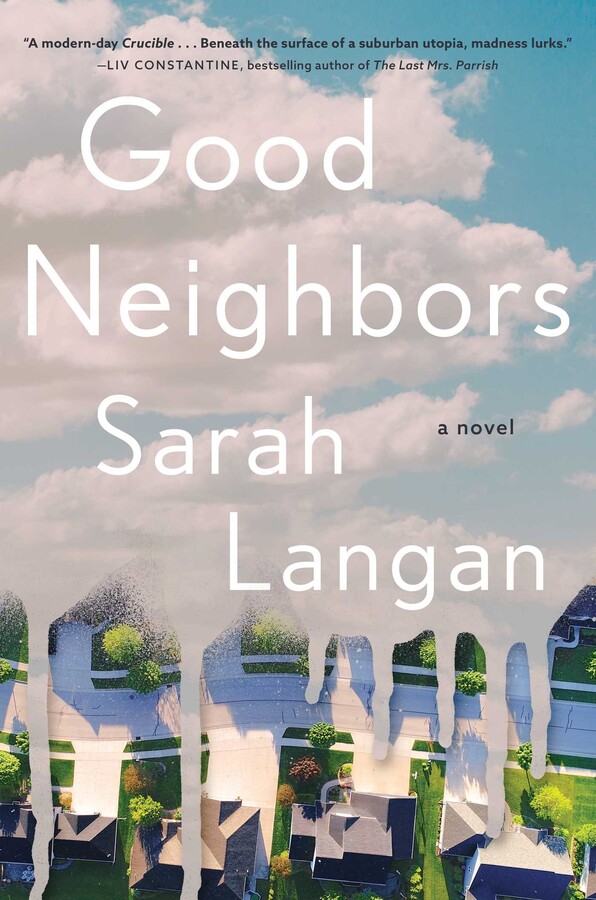Good Neighbors / Sarah Langan
 Atria Books / February 2021
Atria Books / February 2021
Reviewed By: Vince A. Liaguno
British writer and physicist C.P. Snow posited in his final novel A Coat of Varnish (1979) that “civilization is hideously fragile and there's not much between us and the horrors underneath, just about a coat of varnish.” Sarah Langan’s new novel Good Neighbors—her first since 2009’s Audrey’s Door—lends credence to Snow’s assertion in this striking exploration of the psyche of the modern American suburb. Part psychological thriller, part eco-horror, part scathing deconstruction of middle-class suburbia, Good Neighbors is relentlessly tense and savagely grim in its depiction of the suburban façade. It also marks the welcome return of one of fiction’s most insightful and engaging voices.
Maple Street, an idyllic, crescent-shaped enclave on Long Island, presents to the casual observer as the epitome of suburban precision. The lawns are well-manicured, the houses well-maintained, and the denizens themselves a smattering of acceptable middle-class diversity. Everyone smiles and waves and exchanges sidewalk pleasantries. It’s not until the Wilde family moves in—tattooed ex-rocker Arlo, his ex-beauty queen wife, Gertie, their fractious teenage daughter Julia, and younger son, Larry, whose verbal tics and idiosyncratic behavior bespeak his place somewhere on the autism spectrum—that the cracks of this cloistered community begin to show, literally and metaphorically.
The Wildes personify the metaphorical crack on Maple Street. They represent a rung on the social ladder lower than the rest of the residents, and that doesn’t sit well with college professor and queen bee of Maple Street, Rhea Schroeder, whose passive-aggressive machinations preserve the neighborhood’s carefully constructed veneer. At first, Rhea takes the savior tact with the Wildes—and Gertie, in particular. In pulling Gertie closer, Rhea can appear magnanimous while reinforcing how much better, how much more seemingly put together she is than her lower-class counterpart. But as anyone who’s either lived in such a neighborhood or seen The Stepford Wives knows, artifice does not make the sturdiest of foundations. It isn’t long before an incidental drunken confession over cocktails on Rhea’s front porch and a gaping sinkhole that opens up in the neighborhood’s equally idyllic park across the street sets the stage for the unraveling of Maple Street’s meticulously cultivated exterior.
When tragedy strikes, the inhabitants of Maple Street devolve into paranoia and ugliness. Langan shines as she juxtaposes the environmental toxins of the sinkhole against the toxicity of neighborhood gossip and innuendo. As the sinkhole widens and noxious sludge oozes and spreads, so too do the poisonous rumors that pit neighbor against neighbor. Langan expertly builds the tension, and then ratchets it up, until finally letting the lid blow off her literary pot.
Langan’s literary roots are firmly rooted in the horror genre and, although she’s segued after a decade-plus absence into something resembling more of a suspense-thriller with a dash of literary fiction with Good Neighbors, it’s nice to see some of those roots still showing. While the monsters here may not resemble the supernatural terrors at work in her earlier novels like The Keeper or its Bram Stoker Award-winning sequel The Missing, they’re no less terrifying—perhaps even more so because we can recognize and relate to them. If the scariest monsters are indeed those that take human form, Langan gives us a cul-de-sac full of them. Langan does continue down the path taken with her first two books in presenting climate change as an insidious agent of horror, here taking the form of the fissure that opens and swallows at least one of the novel’s characters and serves as the catalyst for the undoing of others. Environmental collapse as the conduit to the collapse of civility—and civilization itself—is a timely and compelling theme that one hopes Langan continues to explore in future works.
Purchase Good Neighbors by Sarah Langan here.



